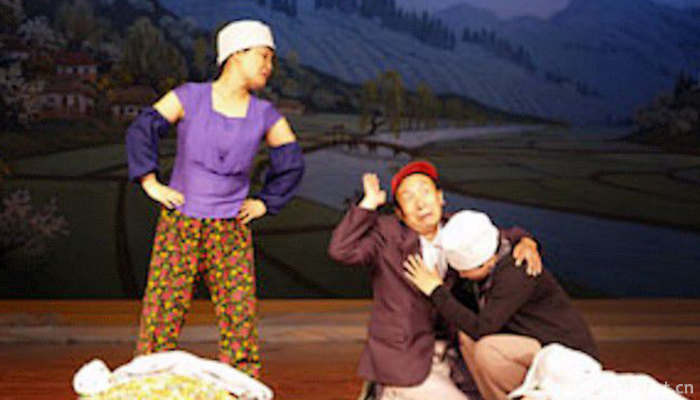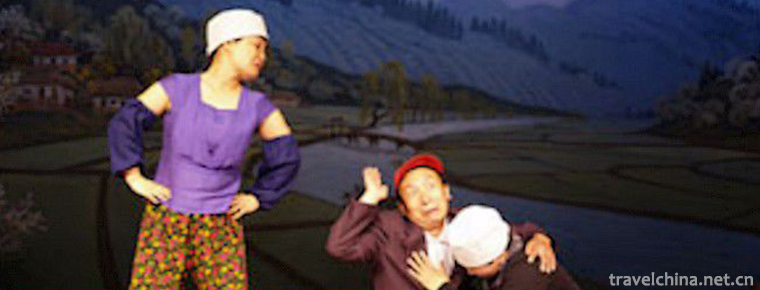Three Old People of Korean Nationality
Three Old People of Korean Nationality
Three Koreans are the traditional folk opera form of the Korean nationality in China. It is composed of three actors who perform in the role of the elderly and merge the forms of Korean opera singing, clown drama and interacting drama. Mainly spread in Jilin Province and Longshi City, it is very popular in the local area.
On June 7, 2008, the "Three Elderly Korean" declared by Jilin Province and Long City was listed in the second batch of national intangible cultural heritage list with the approval of the State Council.
Heritage serial number: 773V-80.
historical origin
As early as the Paleolithic Age in primitive society and in Longshi, human beings had multiplied. The Bohai State had built the capital of Xiande Prefecture in Zhongjing, and achieved the heyday of the Bohai State. Hence, Helong has the reputation of a thousand-year-old capital. In this ancient and vibrant land, the rise and development of the Korean folk art "three old people" is bred. Helong City is a Korean community, and the inheritance and development of folk art has a distinct Korean national flavor. In 1869, Korean hungry people ventured across the border to Ho Long Ken wasteland, which had been banned by the Qing government. The form of "three old people" has gradually developed and formed in the process of production and construction, entertainment and ridicule. Following the end of the Anti-Japanese War in 1945, the celebration of literary and artistic performances prevailed, and the performances were especially popular. The "Three Old Men" melted the characteristics of Korean folk singing, clown drama (Erguangdai), rambling and interacting drama. They mainly praised the national spirit and endowed new contents and performances with them. They were warmly welcomed by the audience and gradually developed and prevailed.
Forms of expression
The three old people are mainly speaking, supplemented by singing. They use the dialect of Yanbian area, which has the local characteristics of Yanbian. The actors simulate three types of old people: progressive, middle and backward, perform in the form of argument, praise advanced figures and new things in laughter, criticize wrong ideas and backward phenomena, laugh at and criticize hostile trends. The three old people are plain and humorous. The advanced are righteous and resolute, showing wisdom. The image of the middle school is both right and left. The dialogue is funny. The laggards are easy to go to extremes. Their minds are simple. The three characters complement each other and become interesting. The contradiction is alleviated and plays an educational role. Some of the lyrics are concise and popular, embellished among them, the music has obvious Korean style characteristics, easy to learn and easy to sing, catchy and catchy. Three old people dress up as humorous and funny, actors are not subject to age constraints, often younger people perform more popular, as for men dress up as women, women dress up as men and other images emerge endlessly.
Inheritance significance
The three old people have the characteristics of stereotyped characters and stylized structures, especially the language humor, which has strong local characteristics. The excavation, rescue and protection of the three elders will play a certain role in promoting the improvement and development of the Korean folk art in Yanbian and the enrichment and perfection of the Chinese minority folk art.
Inheritance and protection
In the process of inheritance of the "Three Old Men", the Helong Art Troupe played a main role. The Helong Art Troupe was founded in 1957. Since its establishment, they have been delivering operas to the countryside in the form of "Kangtou Performance" to inherit the "Five Old Arts". "Five Old Art" is "Three Old Men" and "Two Old Men Singing Together". By 2010, the performance form of "Three Old Men" has been passed down for five generations in the troupe, and more than 20 inheritors have been trained. In 2007, "Three Elderly People in Korea" was selected into the national intangible cultural heritage list.


-
1.Hao River
Haohe River surrounds the old city of Nantong, like a gourd, like a Pearl chain, known as the "emerald necklace" of Nantong City. It is a national 5A tourist attraction.
Time 2018-12-06 -
2.Laiwu Campaign Memorial
Laiwu Campaign Memorial Hall is situated on the Huangshan Mountain in Laiwu District, Jinan City. It covers an area of 45,000 square meters and has a building area of more than 8,000 square meters
Time 2019-01-29 -
3.Wulingyuan
Wulingyuan Scenic Spot is located in the northwest of Hunan Province, central China. Its longitude is 110 20'30 ~110 41'15 and latitude is 29 16'25 ~29 24'25
Time 2019-02-24 -
4.Tibetan Gesar Painted Stone Carvings
Tibetan Gesar painted stone carvings belong to a relic of Chinese Tibetan Gesar culture. They are mainly distributed in Seda, Shiqu and Danba counties in Ganzi Tibetan
Time 2019-04-06 -
5.Kazakh Karakol Leha
On May 23, 2011, Kazakh Karakol Kazakh was listed in the third batch of national intangible cultural heritage list with the approval of the State Council.
Time 2019-05-02 -
6.South China Sea Channel
South China Sea Channel is a traditional folk culture in Wenchang City, Hainan Province. Local fishermen have compiled their own "secret book" for navigation since ancient times. It is a han
Time 2019-06-07 -
7.Nanyin Rap
Nanyin rap is a form of rap sung in Guangzhou dialect. It is also a common melody in Cantonese opera and Cantonese opera. It is said that Nanyin rap was developed on the basis of wooden fish and drago
Time 2019-06-07 -
8.Tiger dance shua laohu
Tiger dance, also known as "playing tiger" ("playing" Jiaozuo dialect refers to "playing" and "performing"), is said to have appeared in the Western Han Dynasty
Time 2019-06-15 -
9.Siming Nanci
Siming Southern Ci is also called "Siming Documents". A kind of traditional local folk art in Zhejiang Province. Tanci, spoken and sung in Ningbo dialect. It is popular in Ningbo, Zhejiang P
Time 2019-06-16 -
10.Tianjin Timing
Tianjin tune originated from Ming and Qing Xiaoqu. It was formed in the late Qing Dynasty and spread in the early Republic of China. It was sung in Tianjin dialect. The performance form of Tianjin Dia
Time 2019-06-20 -
11.Population of Mianyang
By the end of 2018, the total number of households in Mianyang was 2 million 61 thousand and 800, and the registered residence population was 5 million 362 thousand. At the end of the year, there were 4.857 million permanent residents, with the urbanization
Time 2020-12-14 -
12.Yibin transportation
Yibin is a transportation hub city in South Sichuan, which is famous for its comprehensive three-dimensional transportation network of water, land and air. It is located at the starting point of the golden waterway of the Yangtze River and the strategic point of Sichuan Yunna
Time 2020-12-18